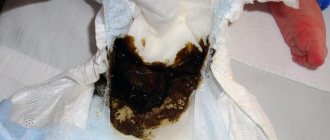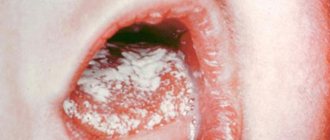Baby feces
Already from the first hours of birth, the baby begins the process of defecation. Original stool is called meconium. They have a viscous, dark green consistency.
While the digestive system adapts to new conditions, feces are heterogeneous in nature: they include mucus and greenish inclusions, but they do not smell and are quickly washed off the diaper.
A week after giving birth, the mass begins to change color and has an odor. How normal it will be in a child depends on the mother’s diet or the quality of artificial nutrition.
Normally, the baby's stool takes on a mustard or brownish tint. Feces are pigmented by bile acids that enter the stomach during digestion.
What to do if your newborn's bowel movements change
Changes in the color and consistency of feces and the appearance of various unpleasant “odors” can be the result of both nutritional reasons, including from the nursing mother, and pathological processes in the baby’s body.
The following symptoms that develop against the background of changes in the organoleptic characteristics of excrement indicate a pathological process in the gastrointestinal tract of a newborn:
The quality and frequency of stool depend on the nutrition of mother and child, health, heredity and age of the baby
- violation of the frequency and rhythm of bowel movements;
- pale skin;
- vomit;
- breast refusal;
- increased body temperature;
- restless behavior.
The situation is especially serious if the child has loose stools that smell of fish. This indicates diseases that are dangerous for the baby such as salmonellosis or cholera.
If there is bloating in the tummy, frequent passage of gas, as well as an unpleasant smell of feces in breastfed infants, the mother should first of all pay attention to her diet. It is necessary to limit the consumption of sugars and carbohydrates as much as possible.
This applies to baked goods, any confectionery products, sweet carbonated drinks and juices that cause fermentation, etc. What foods are allowed and prohibited for a nursing mother in the first month, see here.
You can also discuss your diet with your pediatrician. The doctor will advise which foods are best to eat so that the newborn does not have problems digesting breast milk, and also maintains normal digestion in the woman.
Utkina Yu.A., pediatrician, Alpha Health Center, Samara
Often, a child develops green stools with a sharp, unpleasant odor during the transition from breast milk to formula. Then, together with your doctor, you need to select a different milk food that is well absorbed by the baby’s body.
To select the optimal result, sometimes you have to change the mixture several times.
The appearance of varying degrees of intensity of green coloration of feces requires control feeding with weighing of the baby before and after meals, because this may indicate that the baby is malnourished. It is better to carry out the weighing procedure together with the nurse in the pediatric office. Also, the reason for the green color of the excrement may be too high the fat content of the milk. Find out how to increase the fat content of breast milk here.
If pathogenic microflora is isolated during the analysis of the baby's stool, the mother must submit breast milk for testing for sterility. It is quite possible that the cause of the child’s gastrointestinal tract problems is precisely health problems on the part of the mother .
Is a sour smell normal?
In a newborn at 2 months, not only the color of the stool changes, but also a specific aroma appears. If the stool smells slightly sour, this smell can be considered normal for both a three-month and a one-year-old child.
Amber is provoked by milk sugar entering the baby’s gastrointestinal tract during feeding. It is broken down in the stomach and the reaction produces a sour aroma .
But a pronounced, pungent odor is already a reason to observe the baby in order to evaluate why such a sign arose. Especially if it is accompanied by a change in the color of the stool.
Main reasons
The unpleasant odor during children's bowel movements usually resembles a bite. Various factors can lead to this, and most of them are internal in nature.
| Problem | Description |
| Poor digestion of breast milk | The baby’s gastrointestinal tract is not fully formed and does not produce the required amount of enzymes responsible for the breakdown of lactose. |
| Fermentative dyspepsia | It is a reaction of the baby’s intestines to a diet violation by the mother (excess sweets, baked goods, carbonated drinks) |
| Inflammation in the colon | There are 2 factors involved – infectious and non-bacterial. Pieces of mucus in the stool indicate that the process has begun. |
| Metabolic failure | Hereditary predisposition to enzyme deficiency |
| Dysbacteriosis | The problem is preceded by the mother or child taking antibacterial antibiotics, which provokes a malfunction of the digestive system |
In a breastfed newborn, disturbances may occur due to the physiological characteristics of milk production.
Some mothers begin to change breasts during one feeding.
In this case, the baby receives exclusively “front” milk, which is oversaturated with sugar. The “back” portions, containing immune cells and fatty elements, do not reach their destination. This is another reason for the development of fermentative dyspepsia.
How stool depends on nutrition
When feeding with breast milk, the color of the stool will be from dark yellow to brown, the consistency will be similar to semolina porridge, and the “aroma” of the stool will be sour milk and rather weakly expressed. There may still be a small amount of inclusions or mucus in the feces, but if the baby is not fussy and gaining weight, there is no need to worry about this. You can find out how to tell if your baby is getting enough breast milk here.
The organoleptic parameters of the feces of a breastfed newborn very much depend on the diet of the nursing mother in the first month. During the first 6 weeks of life, the baby may have bowel movements up to 10 times a day . The older the child gets, the less often bowel movements will occur during the day.
During this period, it is very important to monitor the bowel movements of the newborn for early detection of the development of various pathologies of the gastrointestinal tract.
In bottle-fed babies, the “aroma” of stool will be stronger and the consistency will be thicker. If the color of feces in artificial babies changes to orange, green or almost black, you should urgently show the baby to a doctor.
Kuznetsova M.A., pediatrician, candidate of medical sciences, Nearmedic Clinic on Polezhaevskaya, Moscow
If a putrid or sour smell of feces appears in a baby , flatulence, strange inclusions in feces, as well as other manifestations of stomach or intestinal dysfunction, the child should be urgently shown to a local pediatrician.
If a serious condition develops, when, against the background of intestinal changes, the temperature rises and vomiting begins, you must immediately call an ambulance.
Also, bowel movements will be unpleasant for the nose during mixed feeding, when breastfeeding alternates with various milk formulas.
Particularly strong changes in feces will be observed with the introduction of complementary foods into the infant’s diet. The more varied the foods introduced into the baby’s table, the more his excrement will resemble “adults.”
Influence of feeding method
Not all babies are breastfed. Some children are transferred to artificial feeding, so the stool mass will be different.
With hepatitis B
If a child is breastfed, his own microflora is formed within 10 days.
Due to the activity of beneficial microorganisms, the stool acquires a mushy consistency and a sour smell of kefir or cottage cheese, and should not cause concern.
With artificial feeding
When a baby is immediately transferred to formula milk, the stool is more formed than that of a baby on guard duty. The stool has a uniform, thick consistency, although the color of the stool is similar, and the smell of the stool is typical, but less pronounced.
Acidity increases when complementary foods are introduced to the baby. Pieces of undigested food are found in the stool. If there are no allergic reactions, and solid food does not cause pain, you can ignore the smell of stool.
Breastfeeding and feces
As we have already mentioned, meconium is odorless, since it consists of amniotic fluid, epithelial cells and other substances swallowed by the child. It has a tar-like consistency and black-green color.
In the first 10 days, the baby’s own microflora is formed, and his body gets used to mother’s milk. During this period, the stool has a greenish tint and a consistency similar to porridge. There is also a sour smell of feces in breastfeeding infants.
Then, every day, the child’s feces become more mature. It becomes yellow in color and has a uniform consistency. There may be some minor mucus or white flakes, but don't worry, it's just undigested breast milk. In thickness it resembles sour cream. This type of feces has a slight odor, similar to kefir, cottage cheese or sour milk.
The stool of a breastfed baby may change. It depends on the mother's diet. If your child is not worried about anything and is gaining weight steadily, then there is no reason to worry.
Color changes
Mom should worry when a change in the color of the stool is added to the strong aroma of acid. This is already a clear sign of health problems.
| Color | Peculiarities |
| Colorless | A sign of pathology in the structure of the gallbladder (congenital). There may also be problems with the bile ducts |
| Intensely bright | It is observed when there is a Rh conflict between mother and child, leading to hemolytic anemia in the baby. As a result, the amount of bile pigments produced is greater than necessary |
| Green feces | Caused by a violation of microflora and the development of dysbacteriosis. Can also be a symptom of an inflammatory process in the intestines |
| Black or crimson | If the baby or mother does not take iron-containing medications, then this color of stool indicates internal bleeding. Urgent hospitalization of the child is necessary |
The reasons indicated in the table require mandatory consultation with a supervising physician. The combination of a sour odor and a changed color of the baby’s stool is a reason to examine the child.
What does a putrid smell indicate?
The pungent smell of feces in an infant indicates rotting of protein products in the intestines when the composition of the intestinal microflora changes, i.e. We are most often talking about dysbacteriosis.
A putrid stench from newborn feces appears when:
- Inflammatory bowel diseases.
- Slow motility of intestinal smooth muscles.
- Indigestion of a putrid nature.
- Dysbacteriosis.
- Various disorders of the digestion process.
The foul odor of feces, if there is mucus in it, indicates pathological processes in the intestines that appear as a result of allergic reactions , as well as exposure to an infectious or toxic agent on the baby’s body. Another reason for the appearance of mucus in excrement against the background of their unpleasant “odors” is dysbacteriosis. You can find out how and where to get tested for dysbacteriosis here.
If a strong stench from excrement appears in an infant, you should urgently contact a pediatrician for a thorough examination and identify the reasons that caused this condition!
Change in stool consistency
The stool may not change its color, but the non-standard consistency of the mass should cause concern.
Dangerous species include the following:
- watery and foamy stools are the result of lactase deficiency, and the masses acquire a greenish tint, an accompanying symptom is increased gas formation;
- liquid stool of the usual color is a viral or bacterial infection; if the shade has changed to green, mucus, foam or blood have appeared, and bowel movements have become more frequent, there is a suspicion of progressive dysbacteriosis;
- oily, thick stool is evidence that the pancreas does not fully produce the important enzyme lipase; as a result, fats are not processed and are excreted along with the feces.
Sometimes feces leave watery streaks around them on diapers or onesies. If this happens in the first 10 days of life, the situation can be considered normal.
When such periods occur at a later date, the child should be shown to a pediatrician.
What other smells do feces have?
Baby stool smells differently, but scents other than milky ones should cause mom concern.
Strong unpleasant odor
Foul-smelling amber appears in the feces of babies, regardless of the method of feeding. The unpleasant greenish tint of feces is also added to the aromas. The stool becomes watery and frequent. Sometimes you can see mucus or blood.
This is how food allergies manifest themselves. If the baby is breastfed, then the mother’s entire menu, which includes the wrong foods, is to blame.
A child on IV reacts sensitively to low-quality formulas, so you need to choose hypoallergenic formulas for nutrition.
Putrid smell
Such “flavors” are produced by frequent loose stools that have changed their color to an atypical one. Symptoms include vomiting, abdominal pain, and hyperthermia. All this is clear evidence of an infection developing in the gastrointestinal tract (most often rotavirus).
sour smell of feces in infants
A breastfed (BF) child has the right to any chair. This means that the color of stool should be the last thing the mother worries about if the baby is calm, cheerful, developing and growing normally. How does a baby's stool change in the first months of life? (please note that we are talking about the stool of a child who is completely on breastfeeding. On breastfeeding and even more so on IV, everything is different, and even supplementing with water can affect the stool. The standards we are writing about refer to 100% breastfeeding without complementary foods up to 6 months) From birth to 2-3 days - maconium, thick, black-green, 2 to 4 times a day. If not, supplement with expressed colostrum from a pipette. The absence of dirty diapers is fraught with increased bilirubin (jaundice) and weight loss (more than 7%).
From 2-3 days to 4-6 weeks - more than 4 times a day, each dose - a little more than a spoonful of liquid curd. Usually the consistency is soft or liquid, the color is mustard. The smell is usually sweet and milky, but can be sour. There may be inclusions of curdled milk. Green stool with foam or mucus - may be associated with changes in weather, active colonization of intestinal flora, mother's illness, mother's diet. This is not always a pathology and you should not immediately run for tests. Red streaks may be from a small crack in the colon, but they usually don't mean anything. At this age, if stool is less than 4 times a day, you should contact a consultant to check whether the child is eating enough, pay attention to weight gain, and the number of peeings. From 4-6 weeks before the introduction of complementary foods - the norm is from 10 times a day to 1 time in 10 days. The color and consistency may vary, if nothing else bothers the child - this is not a problem. Mucus, white lumps, etc., and sometimes green things are most likely normal. The color is often yellow or mustard. After the introduction of complementary foods (6 months), the feces become “adult” and acquire a much more unpleasant odor. Sometimes with pieces of undigested food. Frequency 1-2 times every 1-3 days. If a child does not have constipation or diarrhea with pain, he is healthy, and reddish or dark stool is not a problem, the intestines learn to digest adult food. Diarrhea in an infant looks like water, usually white, almost transparent or greenish, sometimes with a strong smell. It will be accompanied by other symptoms - fever, pain, vomiting, anxious behavior. Very liquid stool that is yellow or even greenish, with a normal odor (or slightly sour), in the absence of other symptoms, is the norm. Sometimes tooth growth is combined with liquid and acidic feces - no treatment is necessary. Just carry it more in your arms and put it on your chest more often, and wait for the teeth to grow.
Is treatment necessary?
The sour smell itself is not an indicator of deviation from the norm. But a number of accompanying symptoms should alert parents.
When to call an ambulance
Urgent seeking help is necessary in the following cases:
- if the stool is colorless or has a black or crimson tint;
- the mass contains mucus and streaks of blood;
- the stool is loose, the child defecates more than 12 times a day.
Any deviation from the norm, accompanied by vomiting, fever, or crying of the baby, requires medical intervention. But you cannot prescribe treatment yourself - this can pose a threat to the child’s life.
In other cases, it is enough for the mother to reconsider her diet if the baby is pregnant and choose the right foods for complementary feeding.
Methods for normalizing stool odor
A growing baby's stool will still have a slight sour odor as long as breast milk (or formula) is present in his diet. But if the aromas are not entirely typical, then before doing anything, the cause of the failure is determined.
Examination of the digestive system plays an important role here.
If the doctor determines that there is no need for medical intervention, the mother can take the following measures:
- feed the baby with one breast for at least half an hour so that he has time to reach the “hind” milk;
- exclude harmful foods from the menu;
- To normalize microflora, take prebiotics (but only in consultation with your doctor).
If complementary foods are poorly digested and come out as coarse particles, then the first portions are administered in a liquid or crushed state in small doses.










